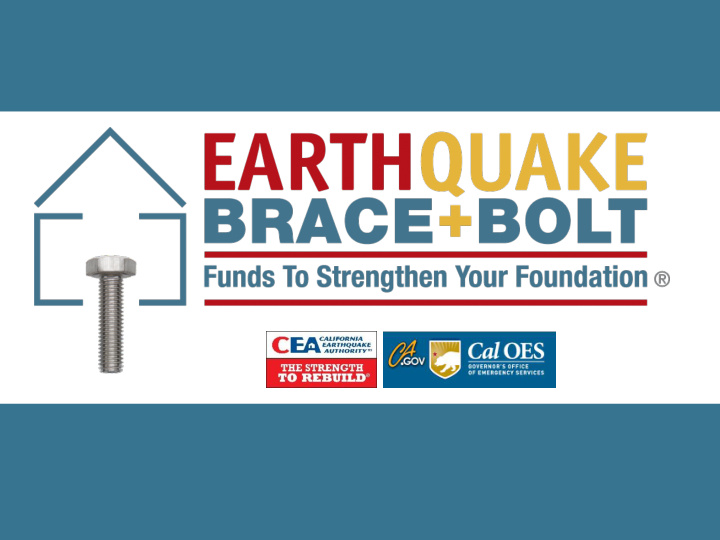



EBB Overview • Jointly managed by CEA and Cal OES • Created to offer retrofit incentives • EBB first to promote code-compliant retrofit • More than 1 Million homes + =
EBB Overview 2017 Marks Year Four • Up to $3,000 • In Accordance with: • Appendix Chapter A3 or Plan Set A or LA City Standard #1 Grown Every Year to More Cities and Zips • Funding is through CEA; however the last two • years we’ve also received $3 Million from the State of California
The Process Timeline: 8 months 2 Months: find contractor and get permit 6 Months: complete work Step 1 : Pre-Retrofit Documentation • Permit language reference in scope of work “Retrofit in accordance with Chapter A3 of the CEBC” “Retrofit in accordance with Plan Set A” “Retrofit in accordance with LA City Standard Plan # 1” • Before photos
Step 2: Complete Retrofit Step 3: Post-Retrofit Documentation Signed building permit • Contractor invoice broken down by materials, labor and • overhead/profit After photos • Payment Authorization From (provided by homeowner only) • IRS W-9 Form (provided by homeowner only) •
The Retrofit Process EBB was created to provide incentives to California Homeowners to seismically retrofit wood-frame residential structures. The Program is limited to funding retrofit expenses that: strengthen cripple walls to enable them to function as shear • members, significantly protecting the dwelling from collapsing; bolt foundation , enabling the dwelling to remain in place, rather • than sliding off the foundation during an earthquake; and properly strap the water heater to reduce the likelihood of water • and fire damage, and to protect the water supply.
The seismic retrofit includes adding anchor bolts and bracing in the crawl space around the perimeter of the foundation to improve the connection between the wooden framing and concrete foundation. Contractors experienced in seismic retrofitting, specifically with California Existing Building Code (CEBC) Chapter A3, 2010 Edition, are sought after for this work.
EBB Retrofit: Sill Plate Anchorage and Cripple Wall Vulnerabilities
Cripple Wall Failure
Dangerous Cripple Wall Damage
Cripple Wall Damage
Cripple Wall Damage
Cripple Wall Damage
Cripple Wall Retrofits Work
The legacy of the “Voluntary Retrofit” Just about anything allowed if it didn’t • make the house unsafe Retrofits were often incomplete • Retrofits were often not effective •
The Code: Chapter A3 The State of California has adopted, effective January 1, 2011, California Existing Building Code (CEBC) Appendix Chapter A3: Prescriptive Provisions for Seismic Strengthening of Crip ipple le Wall lls and Sil ill l Pla late Anchorage of f Lig ight, Wood-Frame Residential Buildings
Code Requirements = EBB Requirements • Code = CBC Appendix Chapter A3 • Engineered retrofit allowed by A3 for: - Cripple walls > 4’ - 0” tall -Walls with many/large openings • Construction Documents = Plan Set A, LA Standard Plan Set or Custom Plans
Why the 4’ - 0” or less Cripple Wall Requirement? 4'-0" high wall does not require a hold-down
Can I use a Plan Set on a house with an attached garage? If the crawlspace area to be retrofitted meets the requirements of the plan set, AND The building official allows it.
Garage Retrofit Often requires engineered solution: • > 4’ - 0” tall wall • Requires prefabricated seismic resisting element
Chapter A3 Prescriptive House
Chapter A3 Prescriptive House
A3 Retrofit Requirements
A3 – Plan Set Comparison
Retrofit Plan Required
Retrofit Plan Required
LABD Sample Plan
LA Standard Plan
Plan Set A
Chapter A3
Prescriptive Details
Condition of Existing Wood • Wood that is part of the retrofit shall be “in sound condition and free from defects” such as: • Fungus • Insect infestation • If damaged, replace with new materials with the same net dimension as the original
Condition of Concrete Foundation • Partial perimeter foundations or unreinforced masonry (brick, stone, etc.) must be evaluated by engineer or architect • New reinforced concrete perimeter footings may be installed using the prescriptive details
Chapter A3 allows New Footing • New foundation may be designed per Figure A3-1 or A3-2, or be designed by an architect or engineer • A local building official may require a soils report
LABD Standard Plan Set allows New Footing
Dwelling Anchorage to Foundation Concept: Install anchor bolts • if space permits If not, install • proprietary or engineered anchors
Dwelling Anchorage to Foundation Concept: Is also applicable to • basement and retaining walls Contact building • department for additional retaining wall concerns
New Anchor Bolts Install with approved washers
New Anchor Bolts with Proper End Distance 9 to 12 Inches from end
Add Replacements Bolts It is not recommended to rely on old anchor bolts
New Foundation Plate (FP) Chapter A3 specifies requirements for fabricated FP
New Foundation Plates
New Foundation Plates
Cripple Wall Bracing Concept: • Install sheathing on inside face of cripple wall to resist load direction F1 • Anchor top plate to floor framing above (load in)
New Plywood Sheathing
New Blocking Mudsill is often wider than cripple wall studs • Blocking required to create a flush face for sheathing •
Properly Placed Nails • Size (8d common) and spacing (4” o.c.) as required by code/plan set • No overdriven nails • No shiners
Connect Wall to Floor Framing Clips Plan Set A allows a Simpson H10 in lieu of Framing Clip
Framing Clip Detail
Vent Holes in Each Stud Bay
Not Seismic Retrofit Chapter A3 (Plan Set) retrofit is at perimeter bearing walls
Not Seismic Retrofit Angles are not approved Chapter A3/Plan Set retrofit
Seismic Retrofit
Seismic Retrofit
Seismic Retrofit
Seismic Retrofit
Contacts • Mark Grissom – Customer Service Manager – mgrissom@calquake.com – 916.661.5520
Recommend
More recommend